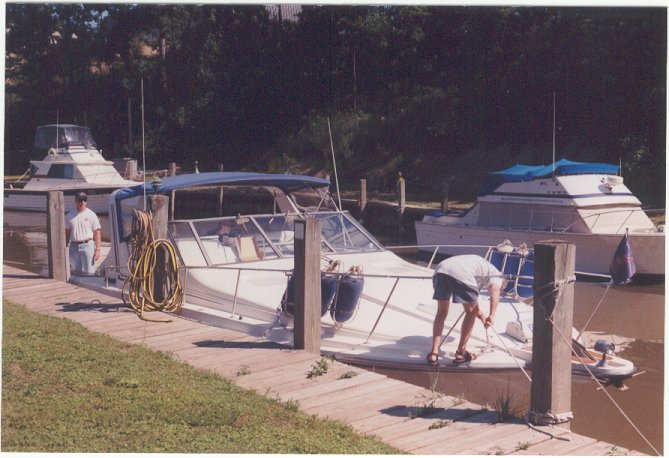
The above is a photo of the Seaduction II docked at Sima Marina off the Chagrin River.
 Alphabetical Shipwreck Index
Alphabetical Shipwreck Index

The above is a photo of the Seaduction II docked at Sima Marina off the Chagrin River. |
|
Our time on the lake is divided between diving known wrecks and searching for those which are lost. In addition, Captain John occasionally assists Discovery Dive Charters out of Wildwood State Park. You will find a link to their site on the previous page.
Like most wreck hunters on the lakes, we are a loosely knit group of amateurs. Some of us are divers, some help man the search instruments, and others come along just for the ride. You will find us out on the water off Cleveland most weekends when the wind and waves permit. In other words, not often enough. Most of the actual maintenance of this web site is done by James Koch during the Fall , Winter, and Spring. Fortunately the Cleveland Public Library has an excellent collection of local and regional newspapers on microfilm from which we are able to derive a wealth of historical information. |
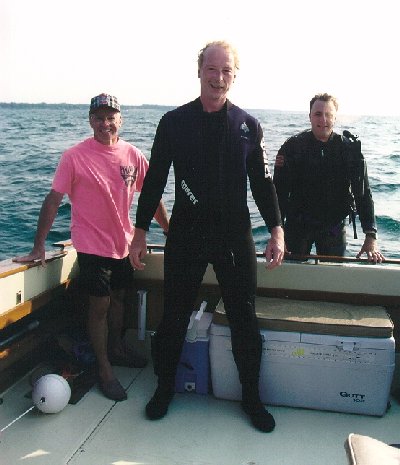
The above is a photo from the summer of 1996. On the left is Scuba John, always the first man in the water and usually the last one out. In the center is our skipper John Koch, the owner of the Seaduction II. To the right is Kevin, just emerging from the water. |
. |
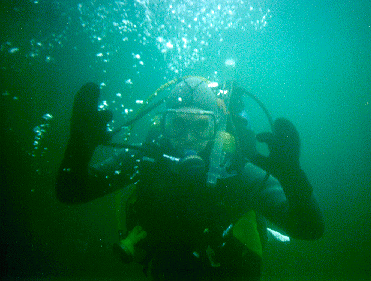
Here's a nice underwater shot of Bronson, who dives by the book. |
. | Wet suits are a must in the lakes. In August Erie's surface waters reach a temperature of around 73 degrees Fahrenheit (23 Degrees Centigrade), which is fine for swimming. However, the wrecks deep enough to be intact (not shredded by the winter ice flows) lie mostly below the thermocline where the water can be a bit chilly. The depth of the central basin of the lake off Cleveland reaches a maximum of about 80 feet. We usually hit 70 feet within a few miles of shore. So most remaining wrecks in our area lie below the thermocline. |
| One of the instruments we use in our searches is a device known as a boat towed proton magnetometer. This is a type of magnetic field detector. It detects metals, but works on a completely different principle from the hand held versions with which most people are familiar. The common hand held metal detector contains a coil through which a constant current is passed. When this coil comes within a few feet of a piece of metal, the field around the coil is disrupted generating a signal. A proton magnetometer is a long range device used to detect much larger objects. The yellow plastic finned probe which is towed 100 feet behind a boat contains a glass cylinder filled with kerosene. Around this is wrapped a magnetic coil. A current is passed through the coil generating a strong magnetic field which polarizes the molecules of the kerosene. At intervals of from 1 to 3 seconds the current is cut and the magnetic field in the coil collapses. This allows the molecules in the kerosene to de-polarize. The rate at which this occurs is dependent upon the earth's magnetic field in the immediate area. A large object like a shipwreck or a mass of iron ore will cause a local disruption in the Earth's magnetic field. Encountering one of these will cause the rate of depolarization to change. Such a change produces a visual signal on the magnetometer screen. The advantage of this device is that it will detect the presence of a large object at a distance from the boat. The disadvantage is that it will signal the presence of geological as well as man made objects and provides no clue as to what is being detected! We have also had problems in the past with false positive readings, false negative readings, and interference from the boat's generators. |
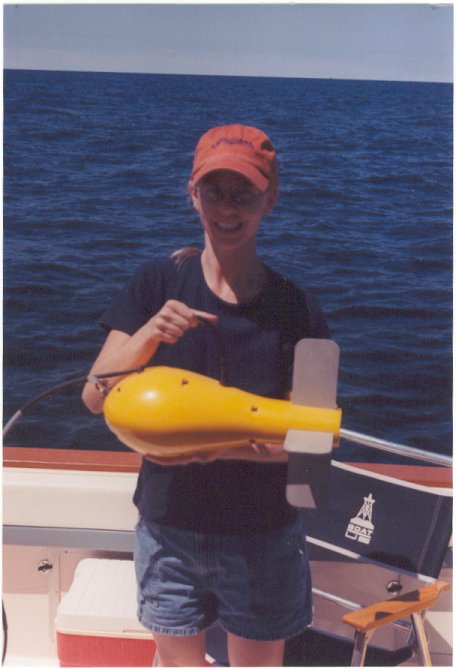
This is Sonar Sarah holding our proton magnetometer tow fish. |
. |
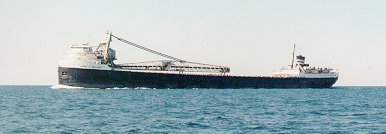
The above is a photo of one of the many typical lake bulk freighters we encounter while dragging our magnetometer over various wreck sites. |
| MapA | MapB | MapC | MapD | Alphabetical Shipwreck Index |